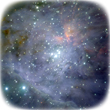

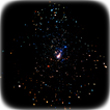


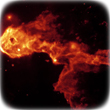
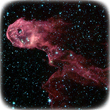
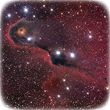
























We start with the outline of the constellation of Orion, which is shown to the left. To the right, we see an image of the same part of the sky that shows both stars and faint wisps of Hydrogen gas glowing red.
- begin zoom -
Now we begin our tour… We first zoom into the heart of the Orion nebula, as seen in visible light. The nebula is a blister of gas heated by young stars on the near edge of a large cloud. The brightest part of the nebula, in the center, is the home of the Trapezium cluster of stars that we have seen earlier in our detective work.
- pan across infrared image begins -
To go deeper into the nebula and obtain a clearer view of the Trapezium, we look at an image of near infrared light from the region. Near infrared light passes more easily through dust and gas than visible light because of its long wavelength. Here we use red to indicate the near-infrared light with the longest wavelength. It betrays another region of star formation beyond the nebula, a second stellar nursery. But, here too, we see dark bands from gas and dust that stop even the near infrared light.
- zoom to mid-infrared light -
So, now it is time to switch to even more penetrating mid-infrared light, which has still longer wavelength. Our picture changes dramatically as we discover glowing pockets of gas and dust deep inside this second stellar nursery. Many may mark the positions of young stars and clusters of young stars.
- white box appears -
The end of our tour comes however with a surprise. When radio astronomers turn their telescopes to this same region, peering through the dust and gas better than can be done at visible or infrared wavelengths, they see a new star – one that must be buried so deeply that its light and heat cannot be directly detected.
Very Long Baseline Array images reveal gas stimulated by the star to emit the radio-wave equivalent of laser beams (seen here in the small, white "X"-shape). They are spread out across a region about the size of our Solar system, or 100 times the distance between the Earth and the Sun. Were it not for these natural lasers, astronomers would have no window into the goings-on this close to a young massive star during its formation.